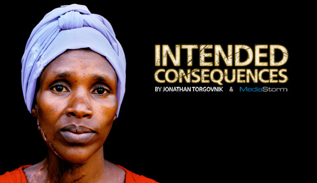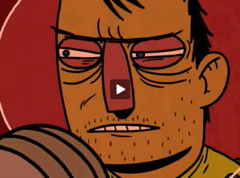Video is everywhere these days … it’s more and more ubiquitous. Often I’ll see an interesting Twitter tweet or other storytelling reference that when I click on it, turns out to be a video.
Nothing wrong with that except that I have zero patience and often am too restless to sit through a video.
Back in the spring, my friend, video storyteller Thomas Clifford wrote a blog entry, “Is This The Future Of Video Storytelling For Organizations?” He was talking about a particular video series on the online Washington Post site, On Being, “video portraits that take you into the musings, passions and quirks of all sorts of people,” but perhaps Clifford’s characterization of these short videos should be used as criteria to evaluate any piece of video that claims to be storytelling:
- Compelling
- Inspiring
- Radically simple
Clifford then asks these questions:
- Can organizations use video narratives as a way to learn from one another?
- Are video narratives an effective way to genuinely engage employees and its customers?
- In a time of information saturation, should organizations integrate narratives into their communications efforts? If so, how?
- Can our individual stories be part of a larger brand’s story?
All great questions that I would like to apply in a broader way to the videos I’m listing here. I’ll return to those presently.
A bit earlier than Clifford’s post, Amanda Hirsch quoted Tom Kennedy from 2002 (who built the award-winning multimedia unit at Washingtonpost.com): “I believe we’re just beginning to scratch the surface of the Web ‘s potential as a story-telling device.” Hirsch’s followup: “Seven years later, I believe we’re still just scratching the surface.”
So, as you review the videos listed here, ask yourself if they demonstrate we are still just scratching the surface in Web-based storytelling, or have we gone beyond? Do these videos pass Clifford’s test of compelling, inspiring, and radically simple? And, now returning to a broader view of Clifford’s questions:
- Can people use video narratives as a way to learn from one another?
- Are video narratives an effective way to genuinely engage Web users?
- In a time of information saturation, should organizations, individuals, and brands integrate narratives into their communications efforts? If so, how?
- Can our individual stories be part of a larger brand’s story, the larger human story, the online content story?
Finally, and perhaps most importantly, do these videos indeed represent storytelling?
- In Passion for the Land, Ranchers and Cooperative Extension agents partner with media artists and UC-Davis university scholars to produce and present digital stories on current challenges to agricultural viability and rural community life in the Sierra Valley. The one I watched, “Is Sustainable Attainable?” was well-done and definitely a story, although I thought the narrator/protagonist was a bit sing-songy in his delivery.
- Ohio State University has developed a reputation as a hub for digital storytelling, and among its impressive set of resources, OSU’s Web site has a section that describes the OSU Digital Storytelling Program’s mission this way: “to help the academic community communicate their passion for teaching, research, and outreach through personal, engaging storytelling.” A collection of “Academic Story Examples” is offered here. I enjoyed The Human Connection. The site also offers a nice set of resources.
- My Facebook friend, Evelyn Van Til, who is also connected with Ohio State — she’s an academic and career coach there — just today sent me the video, “Happiness” (embedded at the bottom of this post), the story of her personal journey to discover that “happiness is created in the daily practice of choosing to see the positive.”
- The storytelling philosophy of MediaStorm, writes Carrie Brown-Smith at The Changing Newsroom (quoting MediaStorm’s Brian Storm), “is to let the subjects speak in their own words. They use on-screen text to connect the dots and drive the narrative, but the audio is in their sources’ own words. They combine stills and video to great effect and always incorporate some kind of surprise for the audience.” This is pretty close to the style Clifford spoke of with the Washington Post‘s On Being series. Defying my personal impatience with watching videos online, Brown-Smith reports that on MediaStorm, 65 percent of those that start watching stic
 k with the site’s 21-minute videos to the end. In explaining why, Brown-Smith perhaps adds three more criteria to what we should be looking for in online storytelling: high quality, easily shareable on social media, and defiant of audience expectations for short-attention-span stuff. I watched Intended Consequences (pictured), about sexual violence during the Rwandan genocide, which was actually just under 15 minutes. I was not impatient.
k with the site’s 21-minute videos to the end. In explaining why, Brown-Smith perhaps adds three more criteria to what we should be looking for in online storytelling: high quality, easily shareable on social media, and defiant of audience expectations for short-attention-span stuff. I watched Intended Consequences (pictured), about sexual violence during the Rwandan genocide, which was actually just under 15 minutes. I was not impatient. - Also rather long (just over 9 minutes) but absolutely stunning is a piece excepted from the TV show “Ukraine’s Got Talent.” Highly touted in the Twitterverse, the video features the show’s winner, Kseniya Simonova, creating a jaw-dropping sand animation that clearly makes a huge emotional impact of every member of the audience. As you watch the video, you can tell the artist is depicting wartime, but the reason for the audience’s outpouring of emotion is unclear until you learn the background, as I did on Associated Content. It is:
-
The Great Patriotic War, or as we call it in America, WWII. Ukraine was probably the area most devastated in the war, even more than Germany. It was a conflict that saw nearly one in four Ukrainians killed. A population of almost 42 million lost between 8 and 11 million people, depending on which estimate one references. Ukraine represented almost 20 percent of all the causalities suffered during WWII. And that was after Stalin had killed millions during the manufactured famines before the war. It to this day touches every Ukrainian.
- Three entertaining and sometimes touching videos are commercials (all re-tweeted many times on Twitter): “Prized Possession” equating home insurance with “a worried dog search[ing] for and ultimately find[ing] the smartest way to protect his most prized-possession;” [Levi’s] “Watch pocket created 1873 … and abused ever since” in which a young man uses his jeans’ watch pocket to stow a condom; and Olympus [Camera]: The PEN Story, “A 50-year journey in stop-motion.”
 In a bit of a different vein is “The Terrible Thing of Alpha-9!”, which is animated. Even though the main character is not human, the story told is very human and tragic.
In a bit of a different vein is “The Terrible Thing of Alpha-9!”, which is animated. Even though the main character is not human, the story told is very human and tragic.- Finally, a collection of videos for a good cause: the Adventist Development and Relief Agency (ADRA) presents Stories from the Field: A Multimedia Collection of Stories from All Over the World (I didn’t have the right plug-in to watch these).
All the videos I saw passed Clifford’s basic tests of compelling, inspiring, and radically simple (some were more compelling than others, and some may not have been quite “radically” simple).
I’m not video-savvy enough to answer whether these demonstrate whether we are still just scratching the surface in Web-based storytelling, or whether we’ve broken new ground.
What do you think? What’s lacking in video storytelling? What’s the next step?
